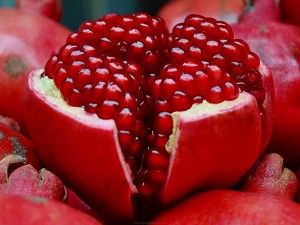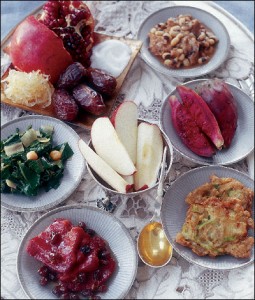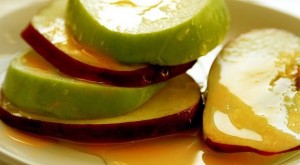Food For Thought: Differences Between Ashkenazi and Sephardi Rosh Hashanah Traditions
 ‘Girl with a Pomegranate’ by William-Adolphe Bouguereau (1825–1905) It’s that time again. Rosh Hashanah, like a smiling bride, tantalized our tongues with apples and honey, round challah with raisins, and hopes for a sweet new year.
‘Girl with a Pomegranate’ by William-Adolphe Bouguereau (1825–1905) It’s that time again. Rosh Hashanah, like a smiling bride, tantalized our tongues with apples and honey, round challah with raisins, and hopes for a sweet new year.
But did you know that not all Jews celebrate Rosh Hashanah this way? While apples and honey is an almost universal tradition these days, it stems from late medieval Ashkenazi roots. Likewise, the wellknown round challah, sweetened with raisins and dipped in honey, as well as lekach – Jewish honey cake – come to us fromthe Eastern European tradition.
Indeed, Israel is truly celebrated as the “Land of Milk and Honey” as Ashkenazim serve disk-shaped sweetened carrots cooked with sugar, raisins or prunes, reminiscent of gold coins.
As for the apple, according to the Vilna Gaon of 18th century Lithuania, it is to remind us of Jacob, who smelled like the field, in contrast to Esau’s blooddrenched odor, when he received his father Isaac’s blessing.
Honey drips with sweetness, pollinating new beginnings in contrast to salt’s sharp sting. Meanwhile, the second night of Rosh Hashanah greeted us with new fruit.
Pomegranates are not taken for granted either. These sweet grenades of flavor so yearned for by the Israelites when they wandered in the desert, promised by Moses to be returned to them when they made it to Eretz Yisrael, are truly savored by Sephardic Jews on this Holy Day.
The fruit’s crown is reminiscent of the Lord’s Kingship, while the seeds symbolize the Torah’s 613 mitzvot. This “grained apple” is thought by some to be the fruit in the Garden of Eden, while for others it conjures up poetic images from the Song of Songs of spiced wines and flowering orchards.
 Just as this fruit is abundantly filled with seeds, so Sephardic Jews pray to Hashem that their lives might be filled with peace and prosperity, a bouquet of mitzvot garnishing their every day.
Just as this fruit is abundantly filled with seeds, so Sephardic Jews pray to Hashem that their lives might be filled with peace and prosperity, a bouquet of mitzvot garnishing their every day.
Sephardim, along with the Mizrachi Jews of the Middle East, practice a special mystical tradition – the Rosh Hashanah Seder, which according to some sources goes back more than 2,000 years. This Seder includes symbolic foods, many of which are based on puns or “signs.” Dates, green beans, pumpkins, leeks, beets, an apple compote called “mansanada,” and the head of a fish are presented alongside the pomegranate on a round dish, representing the wholeness of life.
Like many things in life, whether or not we do something often comes down to the weather. The main differences between traditional Ashkenazi dishes, coming from Russia and Eastern Europe, and those of Sephardi Jewry, with its Spanish, Italian and North African flavors, can be attributed to each culture’s differing climate.
Ashkenazi Jews contended with both poor agricultural conditions as well as a frigid climate, and so their more isolated shtetl existence became rooted in vegetables, poultry and simple meat dishes. The Rosh Hashanah meal thereby took on these hearty attributes, gefilte fish and kreplach – dumplings filled with meat or potatoes – consistently appearing on the dinner table.
In contrast, Sephardic cuisine is typically lighter, substituting rice or couscous for the starchy potatoes, partnered with fresh fruit. Also included are foods unknown to the Jews of Eastern Europe such as: spinach, artichokes, pine nuts, and squash. Jewish merchants traveled to the Iberian peninsula carrying with them unique spices from across the Mediterranean. Intoxicating aromas and exotic flavors, along with drizzling olive oil, combined to both soothe and stimulate the palate.
A typical Sephardic Rosh Hashanah Seder is replete with such foods, each representing the wishes and hopes of its participants in its own way.
Black-eyed peas and fenugreek are stewed with veal to make a dish known as lubiya. The Aramaic “ruvia” meaning “many” or “increasing,” celebrants hope that through prayer and consumption of these vegetables God will “increase their merits” in the coming year.
 Moroccan couscous with seven vegetables is another often-found Seder dish. Each grain is said to represent a blessing or mitzvah, which they could hope to experience, while the number seven is considered good luck and recalls the cosmic act of Creation. Candied quinces are eaten alongside the Shehecheyanu prayer in Morocco.
Moroccan couscous with seven vegetables is another often-found Seder dish. Each grain is said to represent a blessing or mitzvah, which they could hope to experience, while the number seven is considered good luck and recalls the cosmic act of Creation. Candied quinces are eaten alongside the Shehecheyanu prayer in Morocco.
Sephardim also eat leeks, beets and dates, each of which carries its own mystical meaning. Meanwhile, the head of a fish is often used as a substitute for the ancient tradition of presenting a baked ram’s head on the dinner table – a reminder of Abraham’s sacrifice of a ram rather than his first-born son.
The fish’s head represents the desire that we may be leaders not followers, “the head and not the tail.” Fish have a long history of being considered a good symbol in the Jewish tradition, representing fertility as well as prosperity. Also, as fish do not sleep, likewise we are to be “constantly awake” in our desire to be holy.
Some Sephardim, however, avoid fish, thinking it fishy that the Hebrew word “dag” sounds an awful lot like “daagah,” meaning to worry, hoping to minimize their chances of having to worry about worries in the coming new year.
Nuts – “egoz”– are also to be avoided, not because they are lacking, nor for some other egoistic purpose, but rather because the gematria i.e. the numerical value of the Hebrew letters, is similar to that of “chet”- the Hebrew word for “sin.”
Surely, it would be sinful to single out only one such food to avoid, and so we see that some Sephardim also do away with honey. Instead, they dip their traditional flatbread into sugar. The reason? Honey was thought to make the incense in the Temple “impure.”
Today, one may experience dishes such as leek patties, whitefish salad, and pumpkin turnovers, all of which display their Sephardic heritage, while modern-oriented Ashkenazim can enjoy carrot and apple soup, teriyaki salmon, or a decadent slice of honey cheesecake. Kosher creations from roasted lamb to home-made baked beans, red cabbage salad, and fresh figs ensure the holiday to be a truly festive occasion.

